Pizza, Puttanesca, & Suspended Coffee
A Short History
Going back to 1,000 BCE, the Osci and other Italic tribes lived in the area around present-day Naples, but there is evidence of Stone Age peoples in the area hundreds of thousands of years ago.
The Greeks colonized the area as part of Magna-Grecia around the 8th century B.C. Later, the city became part of the Roman Empire.
After the fall of Rome, Naples was subdued by a series of conquerors. Even after establishing the Duchy of Naples in the seventh century A.D. as a province of the Byzantines, and later an independent state, the area was often invaded and entered into sometimes dodgy alliances. For example, Naples allied with the Muslin Saracens in 836 to fight off the Lombards, but by 850 Muhammad I Abu ‘l-Abbas invaded and sacked the city.
The Kingdom of Naples (commonly known as the Kingdom of Sicily) was founded in the 12th century and later came under Spanish rule and Crown of Aragon in the 15th century. Periods of rule by Austria, the Spanish again, and The French followed until 1815 when Naples and Sicily again combined to form the Two Sicilies.
You’d think that with all this conquering and reconquering, Naples would be happy to finally see Italian unification in 1861. But, economic depression followed and millions of Italians left Naples, southern Italy, and Sicily. If you have Italian heritage, your ancestors likely came to the U.S. from this region and they probably left Italy in the 50 years or so after unification. For those who stayed, conditions in the city worsened with cholera and typhoid becoming epidemic.
During WWII, Naples was Italy’s most heavily bombed city. In 1943, the people of Naples and Italian Resistance rose up against the Nazi occupiers, stopping deportations and destruction planned by the Germans as they began their retreat from the advancing Allies.
While the city has suffered from stubbornly high unemployment, corruption, and Mafia crime, Napoletanos remain proud of their culturally vibrant and historically fascinating city.
Foodie Naples
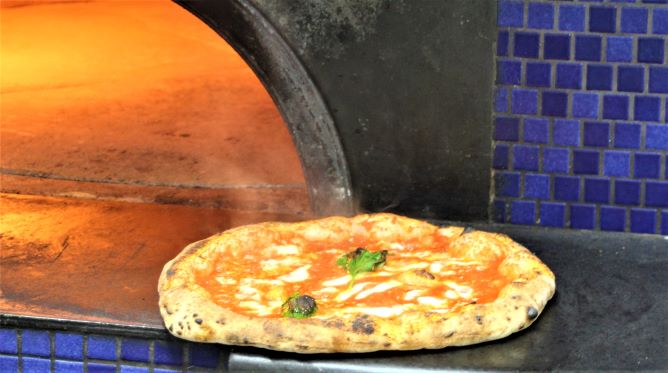
Pizza
Naples claims the title as the originator of pizza and, in my mind, is home to the best pizza in the world. And, believe it or not, there’s more to Neapolitan Pizza than simply Margherita.
First Neapolitan Pizza
People have been putting things on bread to make it tastier for at least 10,000 years. And, the ancient Greeks put oil, herbs, and cheese on pita bread, sort of a proto-pizza, 3,000 years ago. But, modern pizza was invented (evolved, really) in Naples over 200 years ago when tomatoes were added.
The legend of the creation of the famous Pizza Margherita says that Queen Margherita was due to travel from her home in Turin to Naples in 1889. The local big-wigs, wanting to make a good impression, commissioned Naples pizza maker Raffaele Esposito to make a dish to honor the Queen. Mr. Esposito created three pizzas for Margherita to try, including one with the flag colors of the recently unified Italy; red (tomaoto), white (Mozzarella), and green (basil). This pizza was the Queen’s favorite and after her visit she had a note sent to Raffaele expressing how much she enjoyed it.
Raffaele named the new pizza Margherita in honor of the queen and used her stamp of approval to promote his restaurant, Pizzeria di Pietro e Basta Cosi. Today, the note is still posted on the wall of the restaurant which is now called Pizzeria Brandi.
The importance of Neapolitan Pizza cannot be overstated. The popular dish has migrated around the world and there are now countless versions of pizza to be found (New York style, Roman style, Deep dish, Sicilian, Tavern style pizza, etc. etc.) But, the pizza of Naples remains my favorite. It bakes up so nicely in the super-hot wood fired oven, with its crispy and slightly charred, yet chewy crust. My favorites have a raised crust around the edge to hold in the tomato sauce and cheese. And yes, you will eat this with a knife and fork!
Real Neapolitan Pizza is governed by a set of strict rules on ingredients and preparation outlined by Associazione Verace Pizza Napoletana. And, Neapolitan Pizza has been recognized as an Intangible Cultural Heritage item by UNESCO and a Traditional Speciality Guaranteed (TSG) product by the EU.
For me, more important than certifications is the way the pizza is prepared and the ingredients used.
Best Pizza in Naples
Of course, the best pizza in Naples is subject to vociferous debate.
Da Michele got a lot of love even before its appearance in the Julia Roberts movie “Eat, Pray, Love.” After all, the family has been at it since 1870!
Pizzeria Di Matteo also has had famous patrons. President Bill Clinton had pizza here (before he became a vegan) in 1994. Di Matteo makes a great pizza, but get there early for lunch, the line can be long.
Starita does Pizza Fritta, which means the dough is fried, sauce and toppings are added, and then the pie is cooked in a pizza oven. Definitely something to try and quite delicious. Oh, and they’ve had famous people at Starita, too. The Pope visited in 2000.
My favorite pizza in Naples is at Gino Sorbillo. Sure, some folks say it is too touristy, or that their pizza is too earthy, but I love it. I recommend getting there early (before the restaurant opens) if you want to get a seat without waiting too long.
Gino Sorbillo’s has had famous customers, too. A picture of former NYC mayor Bill De Blasio hangs outside. Owner Gino Sorbillo is a bit of a rock star in Italy, appearing frequently on TV shows. A few years ago his restaurant was burned in a fire. The story is that Gino adamantly refuses the Mafia protection money (pizzo) and they burned the shop in retaliation. Two days later, he set up tables on the sidewalk, turned on the ovens, and started making pizza for customers among the debris. My kinda guy.
And the pizza is pretty freakin’ fantastic.
Pizza and the Pope
Shortly after Jorge Mario Bergoglio was elevated to his role as Pope Francis, he was asked what he missed most about his pre-papal life. He said he wanted to go into a restaurant and order a pizza anonymously, something he couldn’t do in his new role.
An enterprising pizza shop owner from Naples, Enzo Cacialli, of Pizzeria Don Ernesto seized on the opportunity. When the Pope visited Naples in 2015, Enzo stood behind the barricades. As the Popemobile made its way down the street, Enzo jumped the barricade and personally handed the Pope a pizza he had made with his own hands.
Afterwards, Pizzeria Don Ernesto took advantage of the publicity. He even had a small TV in the shop showing his encounter with the Pope on an endless loop.
Unfortunately, the story has a less than happy ending. Pizzeria Don Ernesto closed and Enzo was arrested on charges of defrauding the elderly.
I prefer to think of happier times when Enzo was so excited to hand a pizza to the Pope.
Types of Pizza in Naples
The two most famous kinds of Pizza in Naples are Margherita (Mozzarella, tomato sauce, and basil) and Marinara (tomato sauce, garlic, oregano, olive oil). Of course there are many other toppings you can order, but these are the two most traditional.
The Pizza Fritta (Fried Pizza) is also popular in Naples. Then, there’s something called Pizza di Scarola, which is more like a Calzone, stuffed with Escarole.
How to eat pizza in Naples
There’s two basic ways to eat pizza in Naples, with a knife and fork or folded.
If you order a pizza (or a slice) at the counter of a Naples restaurant, it will likely be handed to you folded, often twice. This makes it much easier to eat while walking.
Sit down and order a pizza in a restaurant and you’ll see most people eating it with a knife and fork. This is because the center of Neapolitan Pizza is usually “soupier” than American pizza. Put a slice in your hand and the contents are likely to slide right on to the floor.
This thinner tomato sauce is the reason you will often see people on the street in Naples taking a bit of the folded crust and dipping it into sauce, sorta like a pizza fondue.
Whether you get your pizza sitting down or standing up, pizza is cheap in Naples. Expect to pay 1 to 2 Euro for a slice and 3 to 6 Euro for a whole pie. An incredible bargain, especially when you consider that you’re getting the best pizza in the world!
Fried Pizza
Then, there’s Fried Pizza. As if pizza weren’t perfect enough!
Naples has elevated the frying of everything to a culinary art form. Friggitoria’s (Frying shops) are everywhere, cranking out Crocchè and Mozzarella en Carrozza.
There’s two kinds of Pizza Fritta. The first, and original, has cheese and other ingredients placed between two pizza crusts. The two dough discs are crimped with the filling inside and deep fried.
Masardona’s has been making this kind of fried pizza for three generations in Naples. This is the where to go to get a traditional Pizza Fritta.
If you’ve been to New York, you might’ve seen the second kind of fried pizza, although it too, originated in Naples. For this fried pizza, only the dough is fried. Then, toppings are added and the pizza is baked in a pizza oven.
Starita was the originator of this kind of Pizza Fritta and still the best place to try it, though getting there early is recommended. There always seems to be a huge line.
Friggitoria

When looking for snacks in Naples, the Friggitoria is the place to go. Italian for fryer, the name Friggitoria is apt. Everything is fried. Fried zucchini blossoms, fried eggplant, and my favorite Crocchè. After school lets out, kids line up at the Friggitoria, waiting for their Cuoppo, a brown paper cone filled with all kinds of fried treats.
My favorite is Friggitoria Vomero, a little place that has been in business since 1938 in the exciting Vomero neighborhood. And, next door is one of my favorite places in Vomero, the highly underrated Acunzo. Great pizza.
Crocchè
The most popular thing at the Friggitoria is Crocchè, a mixture of mashed potatoes and egg that is formed into balls, cones and other shapes, covered in bread crumbs and, of course, fried. Similar to a Potato Croquette, Crocchè are absolutely divine, especially when they are fresh out of the fryer.
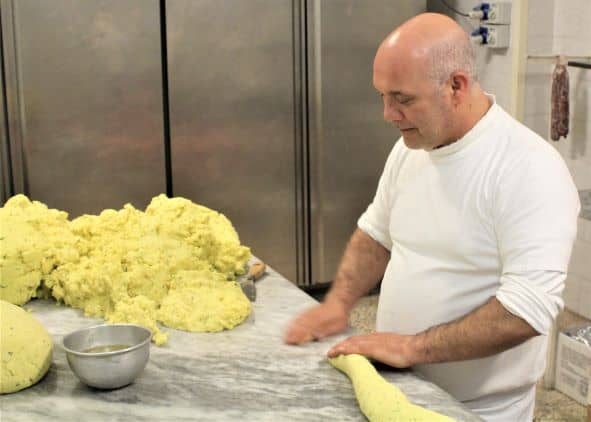
Mozzarella en Carrozza
When I say everything is deep fried in Naples, I mean everything, even a grilled cheese sandwich. Although, if it’s fried, can you really call it grilled?
Anyway, Mozzarella en Carrozza means “Cheese in a Carriage.” We’ve made a limp facsimile in the U.S. known as Mozzarella Sticks, but Mozzarella en Carrozza is something on a much higher plane.
The key to the Mozzarella in Carrozza is the mozz. In southern Italy’s Campania region that means Buffalo Mozzarella, made from the milk of the local water buffalo. For those used to Mozzarella in the states, Buffalo Mozz is a revelation. Richer, creamier, and with a tang not found in typical cow’s milk Mozzarella.
The cheese is placed between two slices of bread, dredged in an egg wash, dunked in bread crumbs and the whole thing is fried (in a fryer or a pan). One variation is to only fry the cheese and then place it on the bread.
Sfogliatelle
Visit almost any Italian bakery in the U.S. and you’ll see Sfogliatelle (sometimes called Lobster Tails, although they are not exactly the same thing) in the display case. The Sfogliatelle’s unique scalloped design makes the dough incredibly flaky, so when a bite is taken little crumbs wind up all over your plate (or your shirt).
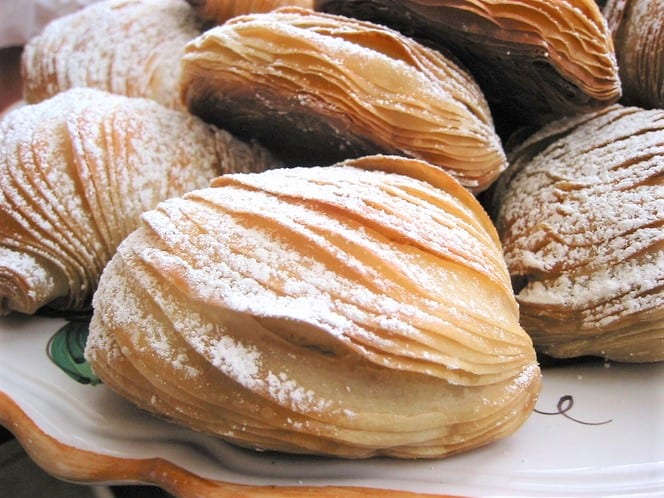
There are two types of Sfogliatelle in Naples; Riccia and Frolla. The Riccia is the more traditional type with the crispy shell while the Frolla is more like a pie crust or shortbread crust. Both are delicious, but I prefer the Riccia in all it’s crispy, crunchy, and sloppy glory.
Like many other great pastry inventions, the Sfogliatelle got its start in a monastery. The Santa Rosa Monastery in Conca dei Marini on the Amalfi Coast is now a luxury hotel and spa, but over 300 years ago, Sfogliatelle was invented here. The recipe was brought to Naples in 1818 when pastry chef Pasquale Pintauro bought the recipe and began making Sfogliatelle in his shop. That shop, Pintauro, is still in operation and sells the crunchy, ricotta filled dreams.
Spaghetti alla Puttanesca
Spaghetti alla Puttanesca literally means “Spaghetti in the style of a prostitute.” Not too appetizing, right?
The original story is that ladies of the evening would make wonderfully smelling sauce to lure gentlemen into their dens of iniquity. That tale is probably not true.
Most people seem to accept the story that is that a cook from Ischia (an island in the Gulf of Naples) prepared the dish quickly using the scant ingredients he had in the kitchen. Tomatoes, Gaeta olives, capers, garlic, red pepper flakes, oregano, and some other spices. Thus, throwing the dish together with whatever you got, or trash on hand, makes it Puttanata. Much better than “Whore’s sauce.”
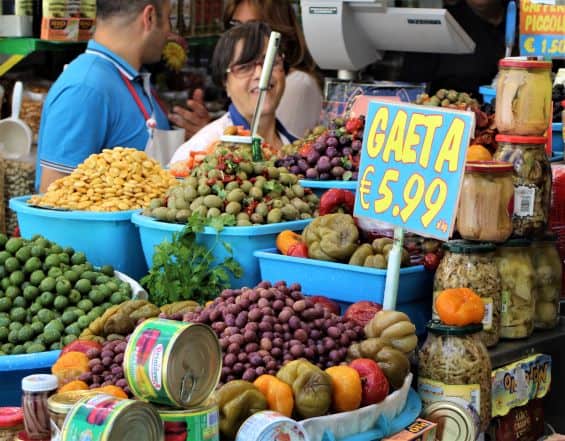
Since this is such a casual dish, variations exist. In the Lazio region, which includes Rome, anchovies are added. Another variant has whole garlic cloves added to the olive oil, but removed before serving.
Rancio Fellone, the restaurant on the island Ischia that probably invented the dish is long gone. But, you can still find Spaghetti alla Puttanesca in Naples’ family-style restaurants like La Brace.
Pasta alla Genovese
When I first heard about Pasta alla Genovese I figured it would be a popular dish in Genoa, the northern Italy port city. And while the dish may have originated in Genoa (no one knows for sure, but it is speculated that Pasta alla Genovese migrated north to south between the two powerful port cities), it is now found almost exclusively in Naples.
The secret to this humble dish is the long, long, long time spent simmering the onions and meat (veal, beef, or pork). This gives the sauce a thick consistency and rich flavor, somewhat reminiscent of French Onion Soup. It’s served with penne or ziti, pastas that can stand up to and grab on to the sauce.
Trattoria Malinconico serves a good version of La Genovese, although it may not be on the menu every single day.
Babà
Babà is one of the most famous treats in Naples, but it didn’t originate here. Instead, it was first made in Poland, then made its way to France when Polish royalty married into Louis XV’s family. Then, chefs serving the royal family in Naples brought Babà to southern Italy.
The distinctive mushroom shaped (I would say hilariously phallic-shaped) yeast cakes are soaked in rum or, this being Campania, Limoncello.
Pasticceria Giovanni Scaturchio has several locations in Naples, including their cafe in Teatro di San Carlo, has nice Babà. Sfogliatella Mary also has very nice Babà, though some purists would object to the fruit (like strawberries and kiwi) that they put on top of their Babà.
Drinking in Naples
Coffee
Naples is my favorite city in Italy for enjoying “un cafe.” Sure, there’s great cups all over Italy, but Naples coffee culture is something special.
I guess the main thing that sets coffee bars apart in Naples is the espresso machines. All around the world, automatic espresso machines have taken over. And for good reason; they are easy to use and make a reliable cup of joe.
So, why do so many coffee shops in Naples use manual spring lever espresso machines? After all, these machines are more difficult to master and require strength to pull the lever; a process the barista will repeat hundreds of times a day.

The answer is the quality of the cup. Napoletanos like their espresso strong and the spring lever machine can better control the intensity of the flavor as well as the pressure that the water is filtered through the machine. This kind of control is more difficult with a modern electronic machine.
Because of the skill required to operate the spring lever machine, t can take quite a long time to learn the skills needed to become a Barista, a job that is respected in Naples. We spoke to an Apprentice at one coffee shop and he said he had be learning the trade for seven years so far and still had yet to touch the machine! It would be several more years before he would become a full fledged Barista.
I’m not sure I was able to taste the difference of an espresso served from spring lever machine as opposed to the electronic ones I’m used to, but I do love the ritual of getting un cafe in Naples.
In Naples, people take their espresso sweet. And the sugar is added before the coffee, so if you like yours without sugar be sure to say ” senza zucchero .”
Most places will dump a teaspoon of sugar, or two, or three, or four into the cup and then add the espresso from the machine. But, at Bar Mexico, they take their ceramic cups and keep them in very hot water until a coffee is ordered. Then, they take the cup from the water and add the sugar. The ceramic cup has retained the heat from the hot water so the sugar begins to caramelize. This adds a richness and depth of flavor to the espresso that makes Bar Mexico my top pick in Naples.

Gambrinus is a jovial folk character probably based on one of a number of medieval kings. He’s often portrayed with a large stein of beer. It seems odd that a coffee house would name itself after Gambrinus, but his name is so legendary in Europe that many restaurants, pubs, and even coffee bars have taken his name.
Caffè Gambrinus, which also serves Aperitivo like an Aperol Spritz, is a Naples fanciest coffee house. This is where poets and left leaning intellectuals (and Oscar Wilde) hung out to discuss high-minded ideas. Mussolini felt threatened by these antifascists, so he shut down Gambrinus in 1938. Today, Caffè Gambrinus is the spot to relive this era in Belle Epoque elegance.
Suspended coffee
One of Naples’ finest customs is the “Caffè Sospeso” or suspended coffee. The idea is simply this; if a person receives good fortune, they will buy two espressos, one for them and a second “suspended” one for a person in need. Later, a disadvantaged person might come into the cafe and ask if there is a suspended coffee available. If there is, they will be given an espresso for free.
The custom of Suspended Coffee originated in Naples one hundred years ago or so when the city was much poorer. A warm cup was a welcome gift for many poor people in the city, even if an espresso has little or no nutritional value. But, after the Italian Economic Miracle of the 50’s & 60’s the tradition died away.
But, when the Worldwide Economic Crisis hit, Suspended Coffee made a comeback. And not just in Naples. Web sites and Facebook pages are dedicated to the idea of paying it forward through Suspended Coffee. There’s even a film about the phenomenon.
Ornate Caffè Gambrinus still practices Caffè Sospeso. I spoke with Michele Sergio, one of the owners of Caffè Gambrinus and he told me that they still give out about 50 Caffè Sospeso every day!
Then there’s the buzzkills at The Consumerist who tamp down the excitement over the Suspended Coffee movement, calling it inefficient. And you know what? They’re right. Homeless people aren’t on Facebook or surfing the Web looking for places that offer free coffee. Baristas could, in theory, slip the free coffee to their friends rather people in need. And, coffee adds little, if any nutritional value to people who already have poor diets. They correctly point out that a better alternative might be keep a pocketful of small denomination gift cards in your pocket and to hand them out to homeless people. Or, ask for your leftovers to be wrapped up by a restaurant (something not commonly done in Europe, unfortunately) and give it to someone in need.
But, the thought of a Suspended Coffee does please me, nonetheless. And, especially in Naples, where a daily espresso is thought of as more of a necessity than a luxury.
Limoncello
Limoncello, the pale yellow after dinner drink from Campania that packs a punch has become wildly popular all over Europe and the U.S.
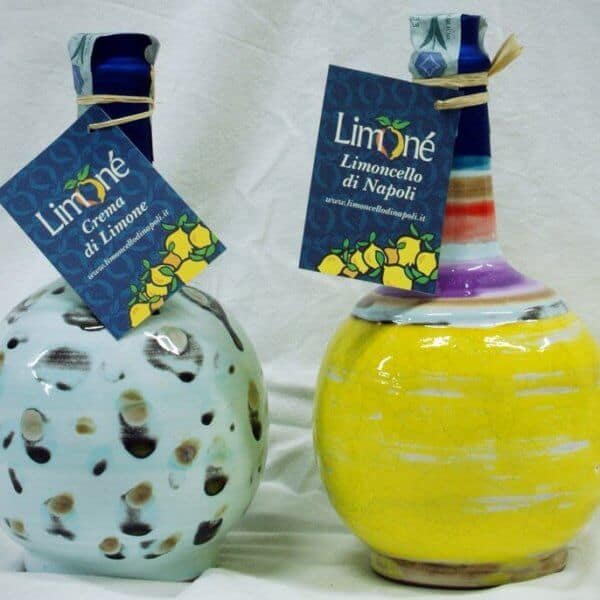
Way back when, our friends Stefi and Luigi owned a restaurant in Warwick, RI called Nonna Cherubina. Don’t look for it, they moved to Spain years ago. In addition to having the best Italian restaurant in a state full of world-class Italian restaurants, Stefi and Luigi were good friends to Karen and I. One of their many acts of kindness was teaching us how to make Limoncello. It seemed like an impossible magic trick back then, but after they showed us, we saw how simple a process it really is. From there, we made the sweet and strong liqueur often and shared it with friends and family. I’ve included a recipe for Limoncello as part of the Amalfi Coast Foodie Travel Guide on Destination Eat Drink. See it here.
The key to a great Limoncello, unsurprisingly, is great lemons. They should have thick, aromatic peels, which is why the Sfumato Lemon is so widely grown in the Campania region.
Limoncello is available at practically every restaurant in Naples and in most bars as well. There’s also a wonderful little Limoncello production factory called Limone. While most of the bottled Limoncello you’ll buy in stores is made in a huge industrial setting, Limone does small batches of their elixir. They also do things a little differently by making Limoncello with Sicilian Verdello, or green, Lemons. These folks are so serious about their product that they peel each lemon by hand. Definitely worth a stop and taste!
Lacryma Christi
Lacryma Christi is a wine variety grown on the slopes of Mount Vesuvius. There are two legends about the origin of the wine. The earliest dates to the ancient Greeks who colonized Naples and planted grape vines. When the Romans arrived they said that Baccus, the Roman winemaking god, wept over the beauty of the land, causing the vines to thrive in the volcanic soil.
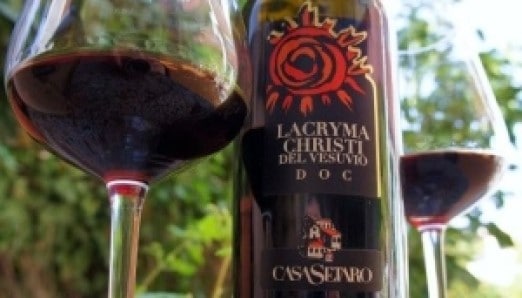
Later, Christians adapted the tale by substituting Jesus for Baccus, thus the name Lacryma Christi.
Lacryma Christi come in both red (made with mostly Piedirosso grapes) and white (made with mostly Coda di Volpe grapes). The red Lacryma Christi is nice because its bold structure can stand up to the rich sauces of Neapolitan cuisine, so it’s great with pizza.
Lacryma Christi wines are readily available as inexpensive table wines at practically any restaurant in Naples. You can also fine good bottles in the U.S. at larger wine shops. Look for the DOCG label. One of the best places in Naples to enjoy a few glasses is Enoteca Belledonne, a nice wine bar with small plates to go with you vino.
Things to Do in Naples
Underground Naples
Naples is built on a soft, porous rock called tufa. This variety of limestone is relatively easy to carve, and starting with the Greeks thousands of years ago, people did just that. Catacombs, tunnels, cemeteries, and escape routes were built over thousands of years and many can be visited today.
Catacombe di San Gennaro
The Catacombe di San Gennaro, and the San Gennaro extra Moenia church that lies on top of the catacombs, are named for Saint Gennaro (aka St. Januarius). The catacombs were first built in the 2nd century A.D. and merged with a later catacomb built in the 4th century used to house the remains of St. Gennaro.

That catacombs are huge, and much less claustrophobic than those in Rome. Archaeologists have logged over 3,000 bodies housed in the catacombs, some bishops, saints, priests, but others, undoubtedly, members of the church.
While alters have been carved from the stone, perhaps the most interesting part of the catacombs is the frescoes painted on the walls. Dating back over 1,500 years, scientists have discovered that a fresco of a family was painted over the course of several years. They think that the fresco may have been updated as each member of the family departed this mortal coil. Imagine going to pay your respects to your family in the underground crypt, seeing their pictures painted on the wall and thinking “someday, my picture will be on that wall, too.”
Get tickets online, they’re just € 9 ( € 6 for children, students, and seniors). But, remember to bring a jacket or sweater. Even on the hottest Naples days, it’s usually chilly underground.
Catacombe di San Gaudioso
The San Gaudioso Catacombs are underneath the Church of Santa Maria della Sanità. But the original tunnels date to Greek times. It was in the 4th and 5th century that the catacombs were used as a crypt and housed the remains of St. Gaudiosus who the catacombs are named for.
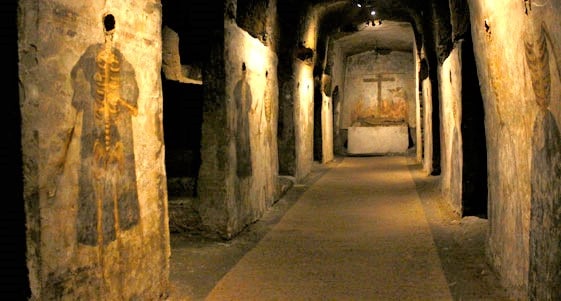
The catacombs were largely abandoned and forgotten in the Middle Ages, during which thieves sacked the tunnels. In the 17th century, the catacombs were rediscovered and used as the burial site for nobles in Naples.
You’ll see skeletal remains and bits of skulls that were placed in tiny alcoves below ground. There’s also impressive frescoes, some of which are more than 1,500 years old. During the tour of the catacombs, you’ll also learn of the gruesome practice of “draining” where the body was prepared for entombment in the underground lair. Probably the worst job ever.
If you go, bring a sweater, it can be chilly down there.
Bourbon Tunnel
In the mid 1800’s the king, Ferdinand II of Bourbon, was terrified of the local populace. He had good reason for this. There had been an uprising in Naples in 1848 and Ferdinand responded by jailing 2,000 revolutionaries. In 1856 one of his own soldiers tried to kill him.
So, Ferdinand was paranoid and decided to build a tunnel from the Royal Palace to the supposed safety of a nearby military barracks.
But, the tunnel was never completed. Ferdinand died in 1859, a revolution happened anyway, and Italy was unified as a single country in 1861.
After Ferdinand died, the unfinished tunnel was mostly forgotten. Then, during WWII, it was used as an air raid shelter and makeshift hospital. People huddled underground and artifacts from that time remain in the tunnel; stuff like gas masks, beds, and toys that children brought down below as they hid from the bombs dropped on their city.
After the war, the tunnel became a dump, so there’s old cars, motorcycles and other trash down there, too.
Incredibly fascinating, and unlike the catacombs that memorialize death, the Bourbon Tunnel is more a reminder of the strength of people’s spirit. And it’s desire to get rid of useless crap.
The Creepy and The Occult
Cappella Sansevero
Naples has more than its fair share of macabre attractions, especially the catacombs housing the skeletal remains of Napoletano from centuries ago. But the Cappella Sansevero takes it to a whole other level.

Originally a family chapel and then a family burial, today the chapel contains several incredible works of art, including the famous Veiled Christ by Giuseppe Sanmartino. The sculpture is an incredible feat, depicting Jesus covered in a thin veil. But, when I look at it, all I can see is the carbonite encased Han Solo from The Empire Strikes Back.

The bizarre “anatomical machines” are housed in the basement of the chapel. A male and female skeleton with “preserved veins and organs.” While the museum paints a picture of the veins being parts of a human body, recent analysis has shown them to be made of beeswax, wire, and silk. Still…
This is definitely a place you want to buy tickets online. Admission is very limited and you can wind up standing in line for quite a while if you don’t have an advance ticket.
Santa Maria della Anime ad Arco (Saint Mary of the Souls of Purgatory)
Catholic churches, especially those in Italy, often are the places where saints and other important people (priests, bishops, the nobility) are entombed. But, what about the destitute?
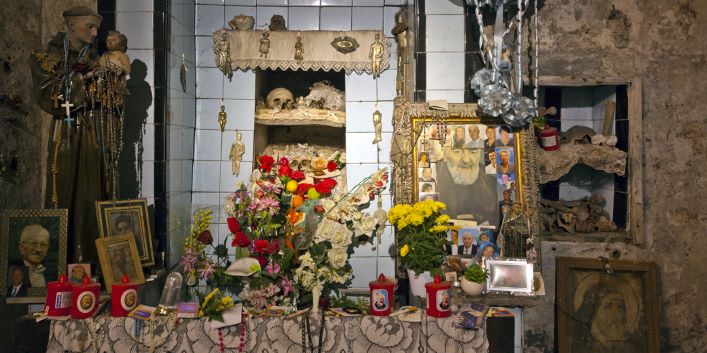
The underground crypt, Anime ad Arco, keeps the bones of these less fortunate Napoletano. The group called the Congrega di Purgatorio ad Arco was formed in the 17th century to provide burial and prayer for the dispossessed of Naples. According to church doctrine, people who didn’t receive a proper Catholic burial would have their souls languish in purgatory. So the Congrega di Purgatorio ad Arco cared for the deceased bodies and prayed for their souls.
This job became especially important during the plague in 1656 when half of the population succumbed. The so-called Skull Cult of Naples polished the bones, especially the skulls, gave them names, and assigned them special powers.
Flowers or gifts often adorn skulls which are thought to have the power to help the living. The Virgin Bride, for example, is believed to help women with their romantic relationships.
While this was a Catholic Church for centuries, the practices of the volunteers at the Santa Maria della Anime ad Arco ultimately ran afoul of the bigwigs and in 1969 the Cardinal of Naples asked that the practice be stopped. It hasn’t and, in fact, may be more popular than ever as a tourist attraction.
The Anime ad Arco isn’t the only Skull Cult of Naples. The Cimitero Fontanelle (Fontanelle Cemetery Caves) are larger than the Anime ad Arco and free to enter (make reservations for tours) and practice the same dedication to helping the dead exit purgatory.
Castles
When you think about castles, visions of fortifications in Germany or Scotland or France might spring to mind. But, Italy has castles, too, and Naples has some especially nice examples.
Castel dell’Ovo
More functional than stylized, Castel dell’Ovo is, nonetheless, situated on a spectacular spot right in the Bay of Naples on the former island of Megaride.
The name, which translates as Egg Castle, comes from the legend that Roman poet Virgil put an egg under the foundation as the castle was built. The story says that if the egg broke, the castle would be destroyed along with the city of Naples.
Now, when people tell this story, the ending is always something along the lines of “and thank goodness the egg remains unbroken and Naples is still standing.” But, the truth is that the original Roman castle, Castellum Lucullanum, was built in the first century B.C. Mount Vesuvius blew up in 79 A.D., destroying much of the area (though, technically, not Napes). Then, in the 9th century the Roman castle was destroyed by the locals to prevent the Muslim Saracen raiders from getting any use out of it. They sacked the city in 850 anyway.

But, the magical powers of Virgil weren’t widely appreciated until the Middle Ages. And, he’s a bit of a local hero in Naples (he’s buried in the grotta vecchia in the Piedigrotta neighborhood). So, when a Norman castle was built in the 12th century, the Egg Castle name given.
When Charles I of Anjou began building Castel Nuovo 100 years later, Egg Castle was forgotten and deteriorated over the centuries until a large renovation project was undertaken in 1975.
The castle often hosts art exhibits and special events, but the real draw is walking along the waterfront and admiring the view.
Castel Nuovo
When the French defeated the Germans in 1266, Charles I of Anjou was elevated to King of Sicily. He promptly moved the seat of power from Palermo to Naples and started building Castel Nuovo. The New Castle was so named to distinguish it from Castel dell’Ovo and was built to house the royals and as a protective fortress.
But, Chuck and his family never moved into the castle. The War of the Sicilian Vespers deposed him and he fled Naples with his army, while the new king, Charles the Lame, took up residence in the New Castle. It was under Robert, King of Naples (Charles the Lame’s son), that the castle was renovated and expanded. The classic turrets, so iconic in medieval castles, were added later.
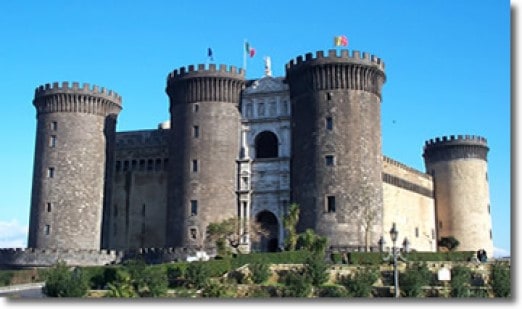
Inside the castle, there’s a museum with some paintings. The castle also hosts events throughout the year. But, it’s really the castle’s striking facade and turrets that are most interesting and those can be viewed from the outside for free.
Castel Sant’Elmo
Originally built during the time of Charles I of Anjou, St. Elmo’s Castle was expanded to its star-shaped design in the 16th century. Not a royal residence, the castle was a military outpost for most of its existence.
Situated on a high point in Naples, the main draw of the castle is the sweeping views of the city and bay below.
I can’t help it, I know this castle was dedicated to Saint Erasmus, but I picture the Sesame Street character roaming the halls with Big Bird and Snuffleupagus.
The castle is next to Certosa e Museo di San Martino with its famous nativity scenes and ceiling fresco.
Vomero
One of the best neighborhoods to explore in Naples is Vomero. Since it’s on a hilltop, the best way to get there is by funicular (Funicolare di Chiaia, Funicolare di Montesanto, or Funicolare Centrale) or the Metro (line 1).
While there’s plenty to do in Vomero, wandering the streets and checking out the prime views of Mount Vesuvius and the Bay of Naples is time well spent.
Food & Drink in Vomero
Some of my favorite spots to eat and drink in Naples are in Vomero. Friggitoria Vomero and Acunzo are close by. Bar Mexico has an outpost in Vomero and Cafe do Brasil makes a fine cup as well.
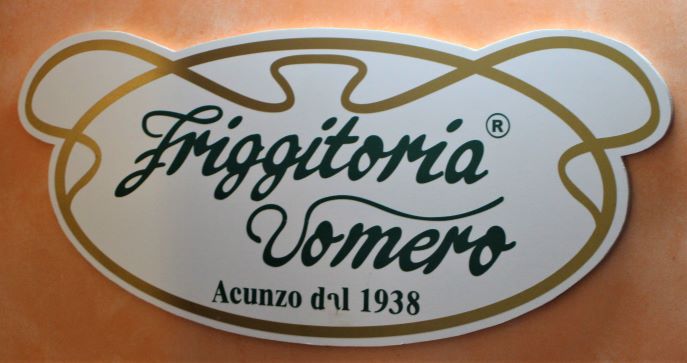
Mercatino di Antignano
For maximum mingling with the locals, Mercatino di Antignano is where to shop. Fruits and veggies along with shoes, housewares, and clothing. Grab some bread and cheese and whatever else you want for a picnic and walk 15 minutes to the urban park Villa Floridiana. Ignore that the general run down and shabby nature of the park and enjoy the views down to the Bay. The actual Villa Floridiana houses a ceramics museum.
Certosa e Museo di San Martino
Built as a French Monastery in the 14th century, the building was abandoned by the order in the 19th century. Today, it houses a museum with pieces from the time that the French and Spanish ruled here, including a nice collection of intricately made presepi (Nativity scenes).
But, the real attraction is the church. Several master works of art are on display including Luca Giordano’s ceiling fresco.
St. Elmo’s Castle is next door.
Holding a commanding position at the top of the town, it’s a hike to get to the Certosa di San Martino, be sure to take the funicular (Morghen Station).
Day Trips
For many people, Naples is just a waypoint on their way to other stops in southern Italy, especially the Amalfi Coast. Hopefully, I’ve convinced you that Naples itself is well worth exploring on its own.
That said, there’s several places close to Naples that make for excellent day trips.
Amalfi Coast
The Amalfi Coast is a jewel, albeit a crowded one, that is worth several days of your time. Or, if you’re squeezed for time, it could be done in a day from Naples.
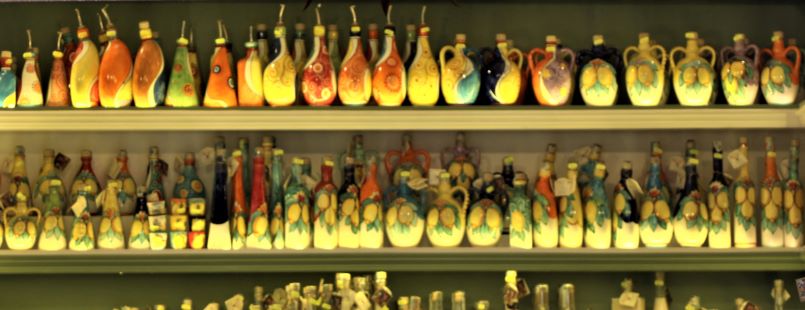
The easiest way to get to the Amalfi Coast from Naples is by train. The Circumvesuviana runs from Naples and terminates in Sorrento, which, while not technically part of the Amalfi Coast, is beautiful in its own right. The trip only takes about an hour.
From Sorrento, its easy to get a bus, taxi, or even a ferry to see the Amalfi Coast.
I’ve written a long form Foodie Travel Guide about the Amalfi Coast.
Mount Vesuvius
In 79 A.D., Mount Vesuvius exploding, spewing ash and lava, killing thousands and destroying cities below, including the famous Pompeii.
Combining Pompeii with Mount Vesuvius is doable, but it makes for a long day. To do both, I recommend taking a tour. Several companies offer full day trips from Naples for between $75 and $150 pp, though true private tours with just you and a driver are much, much more expensive.
Traveling independently is fairly easy. Take the Circumvesuviana train from Naples to the Pompeii station. Buses leave from outside the train station.
Prepare accordingly. It is much colder on Mount Vesuvius than at sea level. Also, the sun is relentless; bring sunscreen. This is a mountain. Be ready to do some climbing. While not overly strenuous, it is a walk that will tire you out a bit. Trail #5 is the most popular and gets you within close range of the volcano itself, which, while still active, hasn’t had an eruption in 70 years.
Pompeii
In 79 AD Pompeii was destroyed by ash and pumice from an eruption at Mount Vesuvius. The city was rediscovered in 1599, but real archeological digging and excavation wasn’t undertaken until the 1700’s. Since then, Pompeii has been a major tourist attraction.
Pompeii is easy to reach from Naples. The Circumvesuviana train leaves Naples Centrale Station regularly and takes less than an hour to reach Pompeii. From there, it’s a quick walk to the Archaeological site.
Outside the entrance gates you’ll see people hanging around who will probably try to sell you a “tour” of Pompeii. These “guides” aren’t registered or regulated, so if you opt to hire one, interview them beforehand to make sure they understand your needs (and language). Buyer beware.
Of course you could buy a ticket from one of the many tour companies that operate out of Naples. Then, you don’t have to worry about the sometimes unreliable Circumvesuviana. Half day tours of Pompeii are available or combine the ruins with Mount Vesuvius. Expect to pay between $75 and $150pp, though if you take a private tour with your own driver you could pay as much as $1,000(!)
Since the various sites inside Pompeii are not labeled, the best way to see the doomed city is with an audio guide. You can rent them at a kiosk near the ticket window.
There’s very little shade at the site. Bring a hat and sunscreen.
Herculaneum
Everyone has heard of Pompeii, but fewer know about Herculaneum, which was also buried in lava and volcanic ash when Mount Vesuvius exploded in 79 AD.
In some ways, Herculaneum is more interesting than Pompeii. While Pompeii is much larger, Herculaneum was wealthier which means the houses and decorations were more luxurious. Also, because of the way the ash and lava fell, wooden structures that burned in Pomepi, were preserved in Herculaneum.
All in all, while Pompeii is by far the more popular site, if you can only go to one town destroyed by lava I’d recommend Herculaneum.
Traveling independently, take the Circumvesuviana to Ercolano. Herculaneum is a short walk. Or, take a tour. Half day tours from Naples are reasonable or you can combine another site like Pompeii with Herculaneum for a full day tour.
Vairano Patenora
There’s no good reason to visit Vairano Patenora. It’s not in any guide book, and it’s only accessible by the milk train that stops in the new town in the valley below the crumbling old town.
That is, unless you’re from Johnston, Rhode Island, where lots of people from Vairano Patenora settled 100+ years ago.
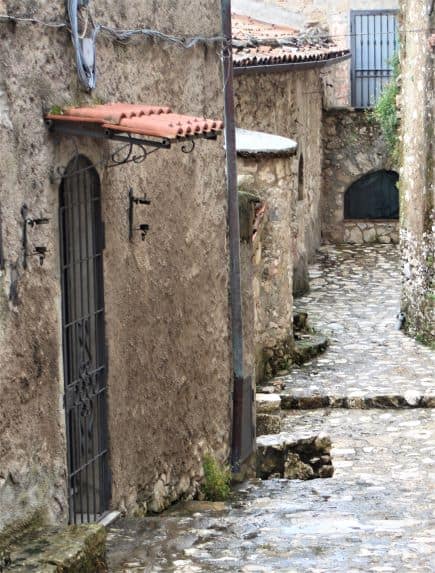
And, since Karen grew up in Johnston, and her grandfather came to the U.S. from Vairano Patenora in the early 1900’s with a couple dollars in his pocket, we needed to make the pilgrimage.
Karen had made contact with a lady who lives half the year in Vairano Patenora and the other half in Johnston, RI where she retired from being a teacher (it turned out she taught Karen’s uncle when he was little!). She took us to the old town on top a hill which was abandoned years and years ago in favor of the easier access to the rest of the world in the new town.
We didn’t see a single other person up there, just a few stray dogs, but it looked like a couple people could be living up there in relative isolation. The church of San Nicola was in a state of disrepair, but it looked like some kind of construction was in progress; it’s going to be a long, tough job.
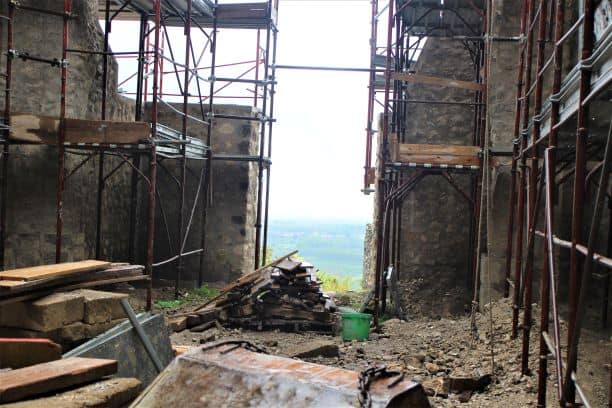
The reason I tell you about Vairano Patenora isn’t to get you to visit there; there’s not much to see unless you’re looking for the ghosts of ancestors or (nothing but) quiet. The reason I tell you about Vairano Patenora is because if you have Italian heritage, I encourage you to do a little digging. Find out where your ancestors are from. The rewards are astounding.
Transportation
Naples International Airport (NAP)
Direct flights from most major European cities, north Africa, and the Middle East. Currently, no direct flights to North America.
Viale F. Ruffo di Calabria, 80144 Napoli NA, Italy
Ground Transportation
There is no Uber in Naples, taxis are reasonable, but drivers can be shady (and drive recklessly!) Be sure to confirm your destination (by writing it down, if possible) and making sure they turn on the meter.
Unico Ailbus
Bus service from the airport to Naples. Convenient and inexpensive.
Napoli Centrale (Naples Central)
Naples main train station. It’s easier to fly into Rome and take the train to Naples (high speed trains take about an hour). Circumvesuviana train to the Amalfi Coast leaves from here. There is also a the Piazza Garibaldi metro stop here.
Piazza Garibaldi, 80142, Naples, Italy
Public Transportation
UnicoCampania is the company that provides public transportation in Naples and the greater province of Campania. The buses, trains, metro, and funicular are all covered by the UnicoCampania TIC ticket, available for purchase at tobacco shops, newspaper stands, and ticket kiosks at stations and many bus stops.
Tickets are available in time increments of 90 minutes, 1 day, 1 week, and 1 month.
Naples is a huge city and I’ve had way scarier taxi rides in Naples than New York City, so I recommend the metro for getting around. It’s much better than sitting in traffic on the bus. Just keep your valuables close and out of sight.
The funiculars (there are four in hilly Naples) are especially fun to ride.
And, the TIC ticket also covers the Circumvesuviana, making your trip to Herculaneum, Pompeii, or the Amalfi Coast easy and inexpensive.
Lastly, always watch for cars in Naples. I’ve seen them drive on sidewalks and blow through red lights. If you’re a pedestrian, you may have the right of way, but that will do you little good if you end up in the hospital.
Index of Things to Do in Naples
Eat in Italy Food Tours
Fun food tours and cooking classes. Highly recommended.
Vesuvius Vs. Pompeii
Excellent food and history tours of Naples.
Museo Archeologico Nazionale (National Archaeological Museum)
Huge displays of Roman, Greek, and Renaissance artifacts including items from Pompeii.
Piazza Museo, 19, 80135 Napoli NA, Italy
Teatro di San Carlo
Oldest working opera house in the world. Tours, too. Next to the Royal Palace.
Via San Carlo, 98, 80132 Napoli NA, Italy
Palazzo Reale
Royal Palace of Naples.
Piazza del Plebiscito 1, 80132, Naples, Italy
Cappella Sansevero
Chapel known for its works of art including the masterpiece Christ Veiled under a Shroud by Giuseppe Sanmartino.
Via Francesco de Sanctis, 19/21, 80134 Naples NA, Italy
Purgatorio ad Arco (Saint Mary of the Souls of Purgatory)
Church dedicated to praying for the souls of the poor of Naples, and housing their skeletal remains.
Via Dei Tribunali 39, 80138, Naples, Italy
Cimitero Fontanelle (Fontanelle Cemetery Caves)
Larger than Purgatorio ad Arco with the same Skull Cult of Naples practices.
Via Fontanelle 80, 80136, Naples, Italy
Certosa e Museo di San Martino
Former monastery with frescoes and intricate nativity scenes.
Largo San Martino 5, 80129, Naples, Italy
Villa Floridiana
Shabby park with nice views of Naples and the Bay. Museum of Ceramics is also on site.
Via Domenico Cimarosa, 77, 80127 Napoli NA, Italy
Museo MADRE
Museum of Contemporary art.
Via Luigi Settembrini, 79, 80139 Naples NA, Italy
Catacombe di San Gennaro
Extensive catacombs dating to the second century A.D.
Via Capodimonte, 13, 80100 Napoli NA, Italy
Catacombe di San Gaudioso
Catacombs with frescoes and mosaics dating to the 4th century.
Basilica Santa Maria della Sanità, Piazza Sanità, 14, 80136 Napoli NA, Italy
Bourbon Tunnel
Tunnel built in the 17th century in case the royals had to flee the unruly populace of Naples.
Parcheggio Morelli, Via Domenico Morelli, 61 c, 80121 Napoli NA, Italy
Basilica di San Francesco di Paola
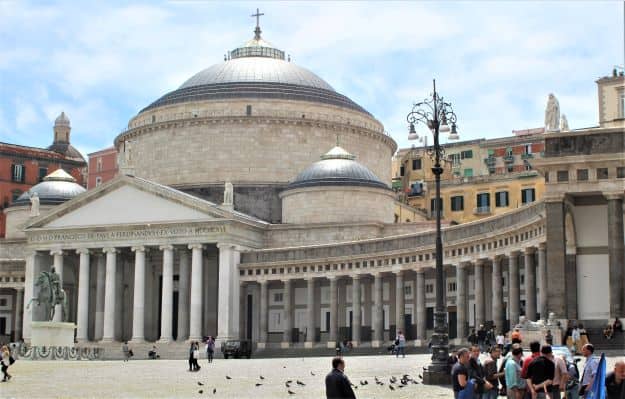
Church with an iconic dome.
Piazza Plebiscito, 80132, Naples, Italy
Chiostro di Santa Chiara
Beautiful garden with incredible painted pillars, benches, etc.
Piazza del Gesù Nuovo, 18, 80134 Naples NA, Italy
Cattedrale di San Gennaro (Naples Cathedral)
Impressive 14th century Gothic cathedral with several updates and renovations in other styles.
Via Duomo 149, 80138, Naples, Italy
Museo di Capodimonte
Huge art museum with works by Raphael and Caravaggio along with more contemporary works in a Bourbon palace.
Via Miano 2, 80131, Naples, Italy
Toledo Metro Stop
Called the most beautiful station in the world.
Via Toledo, 126, Naples, Italy
Castel dell’Ovo
Originally built in the 6th century B.C., the fortification is on a spectacular point right on the Bay of Naples.
Via Eldorado 3, 80132, Naples, Italy
Castel Nuovo
Medieval castle that houses several museums.
Via Vittorio Emanuele III, 80133, Naples, Italy
Castel Sant’Elmo
Sweeping views of Naples and the bay are the main draw to this high point in the city.
Via Tito Angelini 20, 80129, Naples, Italy
Mount Vesuvius National Park
National Park with access to the Mount Vesuvius volcano.
Via Palazzo del Principe, 80044 Ottaviano, Italy
Index of Places to Eat & Drink in Naples
Friggitoria Vomero
Fried food heaven.
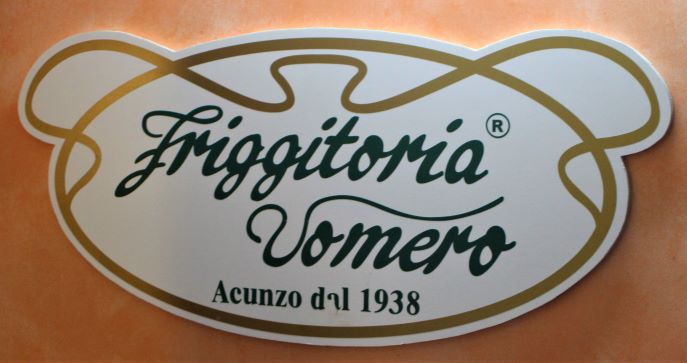
Via Domenico Cimarosa 44, Naples, Italy 80127
Gino Sorbillo
Great Neapolitan pizza. Always crowded. Multiple locations.
Antica Pizza Fritta da Zia Esterina Sorbillo
Fried pizza!
Piazza Trieste e Trento, 53, 80132 Napoli NA, Italy
L’Antica Pizzeria da Michele
Perhaps the most famous pizzeria in Npales, now franchised around the world including L.A. and New York City.
Via Cesare Sersale, 1, 80139 Napoli NA, Italy
Pizzeria Di Matteo
Excellent pizza place made famous when Bill Clinton dined here (before he was vegan)
Via dei Tribunali, 94, 80138 Napoli NA, Italy
Acunzo
Terrific pizza in the Vomero neighborhood.
Via Domenico Cimarosa, 60, 80127 Napoli NA, Italy
Pizzeria Brandi
Pizza Margherita was invented by the original owner, Raffaele Esposito.
Salita S. Anna di Palazzo, 1/2, 80132 Napoli NA, Italy
Cantina del Gallo
Homestyle Neapolitan pizza and pasta.
Via Alessandro Telesino, 21, 80136 Napoli NA, Italy
Umberto
Neapolitan cuisine including a nice Eggplant Parmesan.
Via Alabardieri, 30, 80121 Napoli NA, Italy
La Masardona
The place for Fried Pizza.
Via Giulio Cesare Capaccio, 27, 80142 Napoli NA, Italy
Starita
Makes a wonderful variant of Fried Pizza where only the dough is fried.
Via Materdei, 27/28, 80136 Napoli NA, Italy
Panificio Moccia
Place for Pizzette.
Via Francesco de Sanctis 18, 80134, Naples Italy
La Brace
Spaghetti alla Puttanesca.
Via Silvio Spaventa 14, 80142, Naples, Italy
Trattoria Malinconico
La Genovese (Pasta all Genovese) often on the menu.
Via Giovanni Paisiello, 1, 80128 Napoli NA, Italy
Taverna Estia
Two Michelin starred gem. 25 minute drive out of town in Brusciano.
Via Guido De Ruggiero, 108, 80031 Brusciano NA, Italy
Il Comandante
Top rated restaurant with an excellent location on the top floor of Romeo Hotel.
Via Cristoforo Colombo, 45, 80133 Napoli NA, Italy
George Restaurant
One Michelin star with spectacular views of the Bay of Naples.
Corso Vittorio Emanuele, 135, 80121 Napoli NA, Italy
Palazzo Petrucci
One of Naples top high-end restaurants.
Via Posillipo, 16 C, 80123 Napoli NA, Italy
Bar Mexico
My all-time favorite spot for an espresso. Highest recommendation. 3 locations in Naples.
Piazza Dante 86, 80142, Naples, Italy
Caffè Gambrinus
Beautifully elegant historic cafe for an espresso.
Via Chiaia, 1/2, 80132 Napoli NA, Italy
Cafe do Brasil
Some of the best coffee in the Vomero neighborhood.
Via Luca Giordano, 31, 80127 Napoli NA, Italy
Spazio Nea
Coffee shop/art gallery/cocktail bar
Via Santa Maria di Costantinopoli, 53, 80138 Napoli NA, Italy
Caffè Svelato
Excellent coffee. Locals place.
Via Francesco De Sanctis, 18, Naples, Italy
Il Cuoppo
Lots of fried everything. Always busy.
Via San Biagio Dei Librai, 23, 80138 Napoli NA, Italy
Sfogliatella Mary
When you want a Sfogliatella you go to the place with Sfogliatella in the name. Also have a nice Babà.
Galleria Umberto I, 66, 80132 Napoli NA, Italy
Pasticceria Giovanni Scaturchio
Good place for a Sfogliatella or a Babà.
Piazza S. Domenico Maggiore, 19, 80134 Napoli NA, Italy
Pintauro
Been making Sfogliatella for 200 years, so they got it down.
Via Toledo, 275, 80132 Napoli NA, Italy
Enoteca Belledonne
Excellent wine bar with small plates.
Vico Belledonne a Chiaia, 18, 80121 Napoli NA, Italy
Cammarota Spritz
Not trendy, not touristy, not stylish. In other words, fantastic. Cheap drinks. Lots of college students.
Vico Lungo Teatro Nuovo, 31, 80134 Napoli NA, Italy
Index of Places to Shop in Naples
Limone
The place to get a bottle of Limoncello.
Piazza San Gaetano, 72, 80138 Napoli NA, Italy
Mercato Caramanico di Poggioreale
Outdoor market with tons of clothing, including lots of shoes.
Via Marino di Caramanico, 80143, Naples, Italy
La Pignasecca
Huge market filled with stalls of produce and prepared food.
Via Pignasecca, 80134, Naples, Italy
Christmas Alley
Fans of kitsch will love shopping here for cheap souvenirs, and terracotta nativity scenes. Cash only.
Via S. Gregorio Armeno, 14/58, 80138 Napoli NA, Italy
Mercatino di Antignano
Produce/clothing/knick knack market.
Via Marcello Casale de Bustis, 13-17, 80129 Napoli NA, Italy
Mario Talarico
Unique shop with artisan walking sticks and umbrellas.
Vico Due Porte a Toledo 4/B, 80134, Naples, Italy
Index of Places to Stay in Naples
Bellini House
B&B in the historic center of Naples.
Via Santa Maria di Costantinopoli, 94, 80138 Napoli NA, Italy
Hotel Piazza Bellini
Nice, affordable hotel on Piazza Bellini.
Via Santa Maria di Costantinopoli, 101, 80138 Napoli NA, Italy
NapoliMia Hotel
4 star hotel in the Spanish quarter near the Toledo metro station.
Via Toledo, 323, 80132 Napoli NA, Italy
The Dante House
Modern, quirky B&B.
Piazza Dante, 22, 80135 Napoli NA, Italy
Il Monastero
Stay in a former Monastery right on the Bay of Naples.
Ponte Aragonese, 80077 Ischia NA, Italy
Domus Deorum
Close to the train station, reasonably priced.
Piazza Principe Umberto, 4, 80139 Napoli NA, Italy
About the Author

Brent Petersen is the Editor-in-Chief of Destination Eat Drink. He currently resides in Setubal, Portugal. Brent has written the novel “Truffle Hunt” (Eckhartz Press) and the short story collection “That Bird.” He’s also written several Foodie Travel Guides to cities in Italy including Rome, Palermo, the Amalfi Coast, the Cinque Terre, and Turin. Brent’s podcast, also called Destination Eat Drink, is available on all major podcasting platforms and is distributed by the Radio Misfits Podcast Network.
